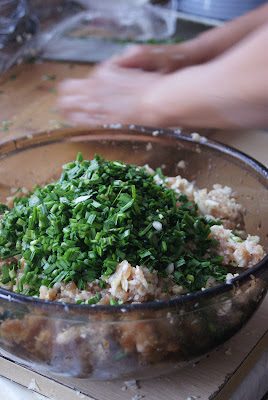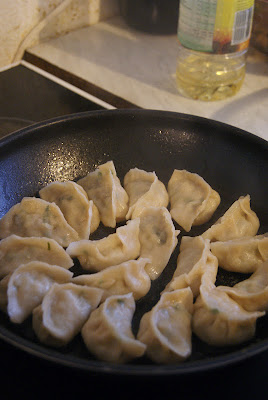Beijing/Guangdong, China
Who would have thought that there is so much to making simple dumplings. They look so easy but there's actually great skills to making these delightful delicacies. Accurate precision is definately required; from the making of the wrapper, preparing the filling to the acual cooking of the dumplings, to ensure a tasty, juicy product is made for the family to eat. This is only able to come with time, experience and practice.
Dumplings are a staple food in northern China. Everyone can make them. The meat used varies between regions; the common meat is pork, but other people prefer beef or lamb, especially in the north-western areas. It is traditional to put Chinese leaf and chive into the filling, but it is possible to put any other leafy vegetables as avaliable. Dumplings are eaten alone as the main meal, and needs no accomliment apart from some vinegar, soy sauce and chilli sauce. The dumpling has meat, vegetables and carbohydrates- everything that you need in a meal! A person can easily eat 20-30 each, and that depends on the size of the dumpling! There are two main ways of cooking the dumplings; boiling and pan-frying, both give a different texture and taste, but are equally as good.
These dumplings have to be eaten during Chinese New Year. Every family make these on the eve of the new year and eat them at 12 midnight, whilst watching the fireworks, to celebrate the new year. The shape of the dumplings look like money, back in olden China, and therefore eating them at the start of the new year symbolises prosperity!
Preparing the dumplings are a reminder of the days spent as a family during the happy celebratory times, where the whole family got together to prepare the dumplings, chat, laugh an reminice about the past. Since, China was quite poor, these dumplings would not be made that often as it contains a lot of meat, which is which is quite expensive.
RECIPE for CHINESE DUMPLING
STEP 1: Making the wrapper- this must be made first, so that you can leave it to rest for at least 30 minutes.
Normal plain flour is adequate to make a good dough for the wrapper.
Mix an egg into a bowl of cold water. If you are making the pan-fried dumplings, you can use warm water which will make the wrapper softer and thinner.
Slowly stir in the water-egg mixture into the flour to form a stiff dough. Take care not to add too much water or it will become too watery. This comes with experience!
Knead the dough until smooth. When a hole is made, it should spring back slowly.
Cover with a damp cloth and leave for 30 minutes
STEP 2: Prepare the filling for the dumplings
The meat is a very important ingredient. Ideally, the mince should be 30% fatty meat and 70% lean meat to create the best flavour combination. Therefore, it is best made from scratch to control the quality. Once the meat is minced, season with a touch of sugar to bring out the flavour, salt, soy sauce and other seasonings are desired. Always season the meat before the vegetables or the salt will draw the water from the vegetables and make the filling too wet.
Chinese chives are often used, as they have a delicious and pungent flavour. They give a great colour and texture. If these are used, then there is no need to use spring onions.
Finely chop the Chinese leaf. Sprinkle with salt to release the water.
After a few minutes, take a handful of the Chinese leaf and squeeze to get rid of the water. Do this over the meat, so that the water and the nutrients are kept in the dish. This is reduce the size of the vegetable as well!
Mixing the meat is one the most important steps of the whole process- it determines whether it will taste good or not. The meat should be mixed with a circular motion in one direction only. The moisture from the vegetables will make the meat sticky and moist. More water can be added to ensure that the meat will be very juicy when cooked.
Add the vegetables to the meat and mix well using hands. Add a drizzle of sesame oil for flavour.
STEP 3: Rolling out the wrappers
A good wooden rolling pin is required for this job! This one has followed Gao Ying for about 15 years- given to her by her family when she left China. Her dad made it shorter so that she could take it away easily.
Prepare a floured surface. Cut off a piece of the dough and roll out into a long sausage shape.

Cut the sausage into half and rollback into a sausage shape.
Cut into small pieces. Twist the sausage dough after every cut.
Press down on the chunks of dough with the palm of your hand to make a small disc. Always press on the cut edge of the dough.


Roll out the discs into larger thinner wrappers. The inside should be thicker than the outer edge. This is a skills that can be only mastered with practise. Some people can roll two at the same time, and others are so fast that this only one perspn rolling and a group of people filling the dunplings! If the discs are not very round, it doesn't matter, as you can adjust it whilst wrapping and a beautiful dunpling shape can still be made.
STEP 4: Filling the dumplings
No water is needed to seal the edges when you are using fresh dough, so it is very quick and easy to make. Put a small amount of the filling in the middle of the wrapper. Fold in half and pinch to seal the edge. Create a few creases and seal.
Done in no time! These can be easily frozen to provide a quick meal or snack.
STEP 5: Cooking the dumplings
There are a few common ways of cooking the dumplings; steaming, boiling and pan-frying.
To pan-fry:
Put the dumplings onto a hot wok. Pour a little oil over the base of the pan to ensure that all the dumplings have a little oil on the bottom.
When the bottom of the dumpling is golden brown, Pour a cup of water around the pan and cover with a lid. Cook until all of the water has evaporated. The dumplings will have cooked.
To boil:
Place the dumplings into a pan of boiling water. Allow the water to boil. Use a spoon and stir along the edge of the pan to loosen the dumplings and allow them to move around the pan.
Pour in a cup of cold water and cover to allow to boil. Repeat. This is to cook the inside of the dumpling. Adding water will stop the water from boiling too much and breaking up the wrapper. Add another cup of water and allow to boil without the lid. This is to cook the skin of the dumpling. When boiled, the dumplings are ready.
STEP 6: Serve up and eat!
Enjoy!
Eat while dumplings are steaming hot with lots of chilli oil, soy sauce and vinegar!





































































No comments:
Post a Comment